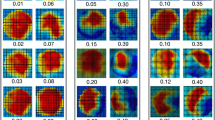Abstract
We used magnetic resonance imaging with cine velocity vector mapping to study blood flow patterns in the thoracic aorta of patients with aortic aneurysms. Spin-echo images of the thoracic aorta were acquired in orthogonal and oblique planes. Cine phase-shift velocity maps were then acquired in selected aortic planes, with velocity encoded in two orthogonal directions. The two-directional velocity data were processed to generate flow vector maps depicting flow distribution in the chosen plane. Diameter ratios between the aortic valves and aneurysmal ascending aortas were reduced, causing blood to enter as a relatively narrow stream with lateral vortical, recirculating flow. In atherosclerotic aneurysms, there was abnormal angulation between the left ventricular outflow tract and ascending aorta, causing the stream to attach to the anterior aortic wall, with recirculating flow posteriorly. In Marfan patients, the primary stream was central with vortices on either side. In patients with coarctation, the main stream attached to the posterior wall of the descending aorta, with recirculation anteriorly. Magnetic resonance imaging with cine velocity mapping allows comprehensive assessment of aortic anatomy and blood flow patterns. Sequential studies at early stages may provide new information about the natural history of aortic aneurysms.
Similar content being viewed by others
References
Holman E (1955) The development of arterial aneurysms.J Surg Gyn Obstr 100 599–611.
Bogren HG, Mohiaddin RH, Klipstein RH, Firmin DN, Underwood SR, Rees RSO, Longmore DB (1989) The function of the aorta in ischemic heart disease: A magnetic resonance and angiographic study of aortic compliance and blood flow patterns.Am Heart J 118 234–247.
Mohiaddin RH, Yang GZ, Kilner PJ (1994) Visualization of flow by vector analysis of multidirectional cine magnetic resonance velocity mapping.J Comput Assist Tomogr 18 383–392.
Roach MR (1977) The effects of bifurcations and stenoses on arterial disease. InCardiovascular Flow Dynamics and Measurements (Hwang NHC and Norman NA, eds) pp 489–539. Baltimore, MD: University Park Press.
Yang GZ, Burger P, Kilner PJ, Mohiaddin RH (1991) In vivo blood flow visualization with magnetic resonance imaging.IEEE Proceedings of Visualization. San Diago, CA, pp. 202–209.
Kilner PJ, Yang GZ, Mohiaddin RH, Firmin DN, Long-more DB (1993) Helical and retrograde secondary flow patterns in the aortic arch studied by three-directional magnetic resonance velocity mapping.Circulation 88 2235–2247.
Walburn FJ, Blick EF, Stein PD (1979) Effect of the branch-to-trunk area ratio on the transition to turbulent: Implications in the cardiovascular system.Biorheology 16 411–417.
Walburn FJ, Stein PD (1981) Effect of vessel tapering on the transition to turbulent flow: Implications in the cardiovascular system.J Biomech Eng 103 116–120.
Stein PD, Sabbah HN (1980) Hemorheology of turbulence.Biorheology 17 301–319.
Firmin DN, Gatehouse PD, Yang GZ, Kilner PJ, Long-more DB (1992) Rapid 7-dimensional imaging of pulsatile flow (Abstract).Soc Magn Reson Med 11 2915.
Gatehouse PD, Firmin DN, Hughes RL, Collins S, Long-more DB (1994) Real time blood flow imaging by spiral scan phase velocity mapping.J Magn Res Med 31 504–512.
Mohiaddin RH, Gatehouse PD, Firmin DN (1994) Exercise-related changes in aortic flow measured by magnetic resonance spiral echo-planar phase-shift velocity mappingJ Magn Reson Image 1994 (in press).
Author information
Authors and Affiliations
Rights and permissions
About this article
Cite this article
Mohiaddin, R.H., Bogren, H.G., Yang, G.Z. et al. Magnetic resonance velocity vector mapping in aortic aneurysms. MAGMA 2, 335–338 (1994). https://doi.org/10.1007/BF01705265
Issue Date:
DOI: https://doi.org/10.1007/BF01705265




